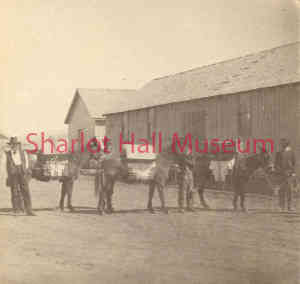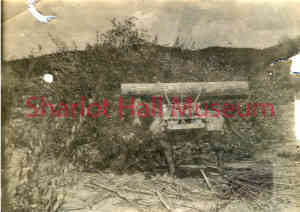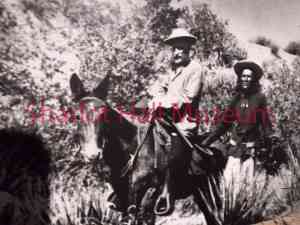By Bob Baker
During the 1800s, mules were an essential part of the settlement and development of Prescott - indeed, of the Arizona Territory. Frontiersmen and early prospectors rode saddle mules and carried their provisions and equipment on pack mules. Early settlers used mules to ride, haul supplies, plow fields and transport equipment. Freight and stage lines often used them on their more mountainous routes. The U.S. Army quickly recognized the mules’ adaptability and began using them to ride and in pack trains in mountainous terrain.
 Mules are not to be confused with donkeys. Mules are hybrid animals created by mating a female horse and a male donkey. They are bred to combine the best characteristics of both animals. The mule is smaller than a horse but larger than a donkey. They are more sure-footed than horses, eat less and can carry more weight pound for pound. Unlike horses, mules will not overwork themselves or put themselves in danger. Some owners viewed this trait as pure stubbornness rather than the mule’s inherent survival instinct.
Mules are not to be confused with donkeys. Mules are hybrid animals created by mating a female horse and a male donkey. They are bred to combine the best characteristics of both animals. The mule is smaller than a horse but larger than a donkey. They are more sure-footed than horses, eat less and can carry more weight pound for pound. Unlike horses, mules will not overwork themselves or put themselves in danger. Some owners viewed this trait as pure stubbornness rather than the mule’s inherent survival instinct.
In his book, “Joseph Reddeford Walker and the Arizona Adventure,” Daniel Connor quotes Walker explaining the importance of mules to his expedition. “Suppose our mules were gone,” he exclaimed. “Why by G-d we couldn’t carry enough provisions to last one hundredth part of the way to civilization.” Early pioneers and settlers of Prescott and the Arizona Territory relied heavily on mules for personal transportation and for providing supplies and public transportation to and from the West Coast. The freight lines (and later the Arizona Stage Line established in 1869) regularly used mule teams to pull their freight wagons and stagecoaches over the mountainous route west. Thus mules were highly prized and valuable property. On May 18, 1867 the Arizona Miner reported the theft of five “splendid mules” by Indians from Toll Gate Station, valued at $1,200 ($25,056 in today’s dollars). On April 18,1868 the Arizona Miner reported, “The Governor arrived on Thursday of this week…His Excellency the Governor, Richard C. McCormick, arrived in an ambulance drawn by four dashing mules.”
 In the late 1800s, mine owners began to use mules instead of men to pull ore carts in their gold and silver mines, as the mules were much more efficient at pulling out ore than men. As mules are smaller and more robust than horses, they were more suited for underground mining operations. After working underground for 3-7 years, they were usually released on the surface to run free.
In the late 1800s, mine owners began to use mules instead of men to pull ore carts in their gold and silver mines, as the mules were much more efficient at pulling out ore than men. As mules are smaller and more robust than horses, they were more suited for underground mining operations. After working underground for 3-7 years, they were usually released on the surface to run free.
Upon his arrival at Fort Whipple in 1871, General George Crook quickly began using mules in pack trains to support his many Indian campaigns. General Crook himself preferred to ride his mule named “Apache” rather than a horse. The April 11, 1866 Arizona Miner contained the following excerpt from General Mason’s general order: “...officers when traveling on public service without troops … will ...be furnished...one saddle mule and one pack mule.” The U.S Army regularly used pack mules to carry supplies, including ammunition and artillery, throughout their campaigns.
 By the late 1930’s, mules lost most of their importance in everyday life, transportation, industry and the military with the advent of mechanization and the automobile. Yet, as late as 2001, the U.S. Army Special Forces used mules in Afghanistan. In June 2004 the U.S. Army belatedly recognized the unique role that mules play in remote combat operations by publishing a new field manual entitled “Special Forces Use of Pack Animals”. After all, the humble mule is still the mascot of the U.S. Army Military Academy at West Point, N.Y.
By the late 1930’s, mules lost most of their importance in everyday life, transportation, industry and the military with the advent of mechanization and the automobile. Yet, as late as 2001, the U.S. Army Special Forces used mules in Afghanistan. In June 2004 the U.S. Army belatedly recognized the unique role that mules play in remote combat operations by publishing a new field manual entitled “Special Forces Use of Pack Animals”. After all, the humble mule is still the mascot of the U.S. Army Military Academy at West Point, N.Y.
“Days Past” is a collaborative project of the Sharlot Hall Museum and the Prescott Corral of Westerners International (www.prescottcorral.org). This and other Days Past articles are also available at archives.sharlothallmuseum.org/articles/days-past-articles/1. The public is encouraged to submit proposed articles and inquiries to dayspast@sharlothallmuseum.org. Please contact SHM Research Center reference desk at 928-445-3122 Ext. 2, or via email at archivesrequest@sharlothallmuseum.org for information or assistance with photo requests.


